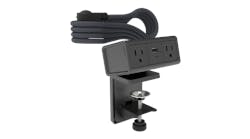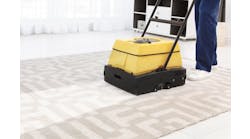Education institutions have a lot of ground to cover—whether it’s a hard surface or a carpeted area. Each type of floor covering has its pros and cons, but no matter what type of surface is present, it must be kept clean and well-maintained to prevent health-related problems stemming from poor indoor air quality.
"Regardless of floor covering type specified, regular and effective cleaning and maintenance is essential to keep the floor covering dry and clean," the EPA says.
For carpeted areas, regular cleaning means vacuuming. The Carpet & Rug Institute says that routine vacuuming is the most important part of any carpet maintenance program. Some areas of a school facility will need vacuuming only once or twice a week, while heavily used areas might need vacuuming once a day or more.
Schools and universities should make sure that vacuum cleaners are operating efficiently so that they collect dirt without releasing unwanted substances back into a room.
"A vacuum cleaner that has an extremely high air flow (suction) has very little value if dust and other contaminants pass through the vacuum bag and become airborne," the Carpet & Rug Institute says. "Efficient vacuum cleaners offer high airflow, high-efficiency filtration, and an adjustable rotating brush agitation for more effective soil removal."
The institute has established a Seal of Approval/Green Label program that evaluates a vacuum’s performance in removing dirt while containing dust in the machine and the filter bag.
Another key step in maintaining good indoor air quality is the use of walk-off mats at school entrances. Whether they lead into a carpeted area or a hard surface, walk-off mats reduce the amount of soil entering a building; dirt is trapped by the mats before it can get farther into the buildings.
Keeping floor surfaces clean is essential for good indoor air quality, but if products are used incorrectly, the cleaning process itself may create air quality problems.
Cleaning products also may release volatile organic compounds (VOCs) into the indoor environment and cause nasal congestion, upper respiratory irritation, headache, nausea, fatigue, and dizziness. In addition, some cleaning products could pose a safety risk if they are improperly stored.
To minimize these potential safety risks, the EPA says, schools should:
•Select products with positive environmental attributes, such as low toxicity, biodegradability, low VOC content and reduced packaging.
•Reduce the amount of harmful chemicals and use them less often.
•Schedule cleanings when the school is unoccupied and is ventilated sufficiently.
The EPA also identifies several practices that have helped schools create and maintain safer and cleaner learning environments:
•Removing all caustic products.
•Providing teachers with one, non-toxic cleaning product for use in classrooms.
•Banning the use of cleaning products with VOCs and heavy metals.
•Allowing the use of only water-based cleaning solutions or products manufactured from renewable resources, such as citrus.
•Using cleaning products that are biodegradable.
Another resource for schools is the EPA’s Environmental Preferable Purchasing program (www.epa.gov/oppt/epp/index.htm). It helps schools and others that buy cleaning products to find and evaluate information about green products and services; identify federal green buying requirements; calculate the costs and benefits of purchasing choices; and manage green purchasing processes.
Kennedy, staff writer, can be reached at [email protected].
Related Stories
Related Video
A video from the Carpet & Rug Institute that shows how carpet improves Indoor Air Quality (IAQ) by acting as a filter.



